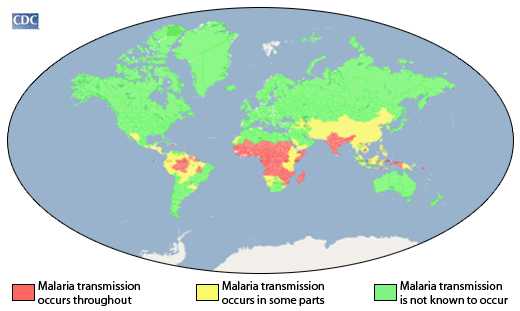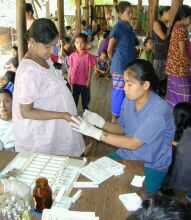Impact of Malaria
Geography
Malaria occurs mostly in poor, tropical and subtropical areas of the world.

This map shows an approximation of the parts of the world where malaria transmission occurs.
Africa is the most affected due to a combination of factors:
- A very efficient mosquito (Anopheles gambiae complex) is responsible for high transmission.
- The predominant parasite species is Plasmodium falciparum, which is the species that is most likely to cause severe malaria and death.
- Local weather conditions often allow transmission to occur year round.
- Scarce resources and socio-economic instability have hindered efficient malaria control activities.
In other areas of the world malaria is a less prominent cause of deaths, but can cause substantial disease and incapacitation, especially in rural areas of some countries in South America and South Asia.
Statistics
Malaria is one of the most severe public health problems worldwide. It is a leading cause of death and disease in many developing countries, where young children and pregnant women are the groups most affected. According to the World Health Organization’s World Malaria Report 2013 and the Global Malaria Action Plan
- 3.2 billion people (half the world’s population) live in areas at risk of malaria transmission in 106 countries and territories
- In 2012, malaria caused an estimated 207 million clinical episodes, and 627,000 deaths. An estimated 91% of deaths in 2010 were in the African Region.
Who Is Most Vulnerable?
The most vulnerable are persons with no or little immunity against the disease. In areas with high transmission (such as Africa south of the Sahara), the most vulnerable groups are:
- Young children, who have not yet developed partial immunity to malaria
- Pregnant women, whose immunity is decreased by pregnancy, especially during the first and second pregnancies
- Travelers or migrants coming from areas with little or no malaria transmission, who lack immunity.
In areas with lower transmission (such as Latin America and Asia), residents are less frequently infected. Many persons may reach adult age without having built protective immunity and are thus susceptible to the disease, including severe and fatal illness.
Social and Economic Toll
Malaria imposes substantial costs to both individuals and governments.
Costs to individuals and their families include purchase of drugs for treating malaria at home; expenses for travel to, and treatment at, dispensaries and clinics; lost days of work; absence from school; expenses for preventive measures; expenses for burial in case of deaths.
Costs to governments include maintenance, supply and staffing of health facilities; purchase of drugs and supplies; public health interventions against malaria, such as insecticide spraying or distribution of insecticide-treated bed nets; lost days of work with resulting loss of income; and lost opportunities for joint economic ventures and tourism.
Direct costs (for example, illness, treatment, premature death) have been estimated to be at least US$ 12 billion per year. The cost in lost economic growth is many times more than that.

Pregnant woman having a blood smear taken at an antenatal clinic at the Maela Camp in Thailand near the Burmese Border. Pregnant women are at increased risk of malaria. Image contributed by the Shoklo Malaria Research Unit, Mae Sot, Thailand.
- Page last reviewed: April 13, 2016
- Page last updated: April 15, 2016
- Content source:


 ShareCompartir
ShareCompartir